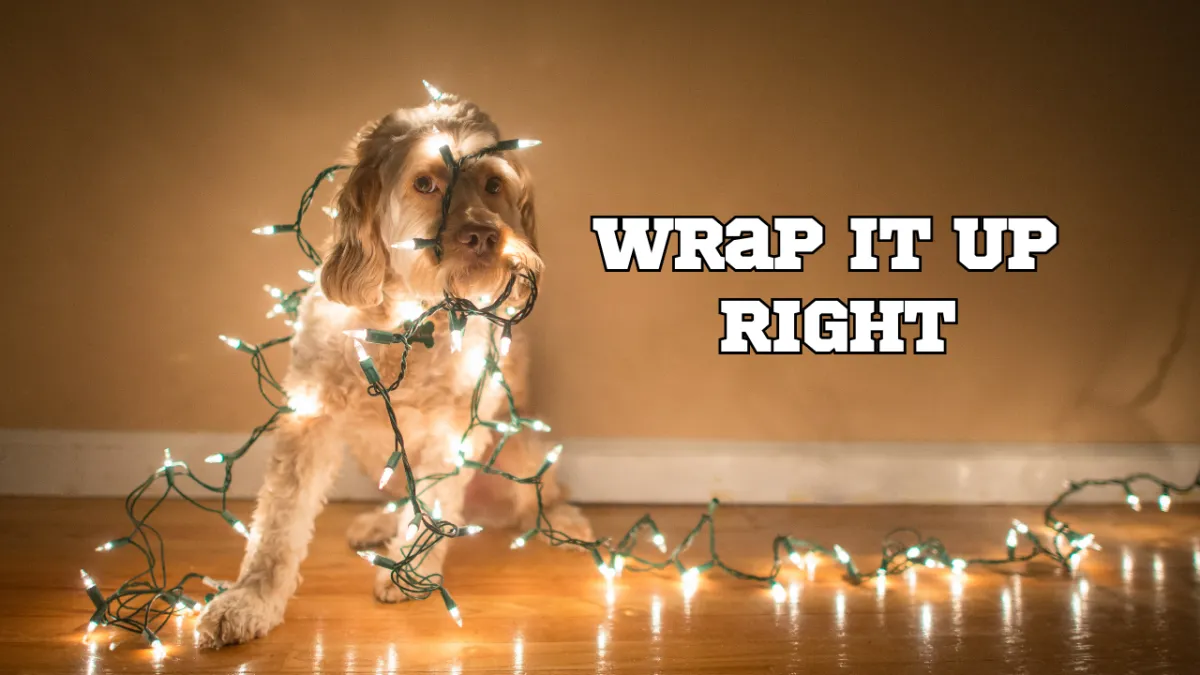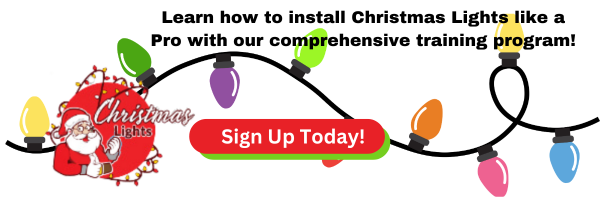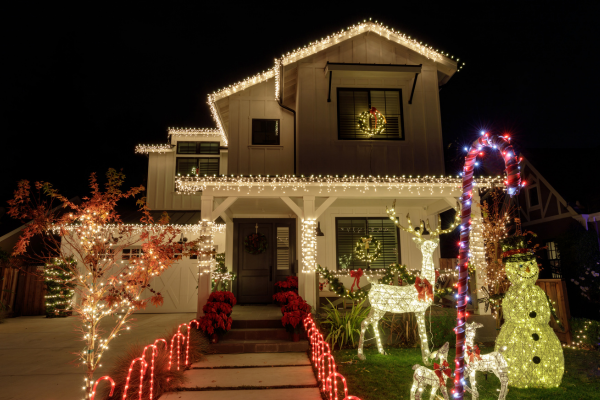Blog
Our Top Blog Posts

Wrap It Up Right: Pro Techniques for Christmas Light Storage
In the era of gas lamps and candles, who would've thought we'd be grappling with the modern conundrum of storing electric Christmas lights? Yet, here you are, facing the annual tangle of wires and bulbs. Before you shove them back into a box and hope for the best, let's pause. Proper storage isn't just about tidiness; it's about preserving the magic and functionality of your lights for years to come. From assessing your storage needs to innovative wrapping techniques, you'll find that a little know-how can transform this chore. Curious about how to keep your lights twinkling bright? Let's unwrap these pro techniques together.

Assessing Your Storage Needs
Before you tuck away your Christmas lights, it's crucial to evaluate your storage space and needs to ensure a hassle-free experience next holiday season. Space considerations are at the top of your list. You've got to determine how much room you've actually got and whether it can accommodate your current and possibly future holiday decorations. It's not just about fitting everything into a corner of the attic or a shelf in the garage; it's about making sure that space works for you.
Humidity control can't be overlooked either. If you're storing your lights in a place that's prone to dampness or fluctuations in temperature, you're asking for trouble. Moisture can corrode the wiring and bulbs, leaving you with a non-functional set when you need them the most. Look for a storage area that's dry and maintains a relatively stable temperature year-round.
Accessibility importance is another key factor. You don't want to be moving mountains every time you need to get your lights out or put them away. Choose a storage spot that's easy to reach and doesn't require you to empty half your garage or attic just to access.
An inventory checklist is your best friend. Before you store your lights, take a moment to note what you have. This way, you won't be scratching your head next year, wondering if you need to buy more lights.
Lastly, don't skimp on protection materials. Soft, padded storage bags or containers can prevent damage to your lights while they're tucked away. A little extra protection now means you won't be dealing with broken bulbs or tangled wires later.

Detangling Before Storage
Once you've sorted out your storage space and needs, it's time to tackle detangling your Christmas lights for a smoother packing process. Detangling might seem daunting, but with the right approach, it's a breeze. Before you dive in, consider light lubrication - a little goes a long way in making the strands easier to handle and less prone to snags and knots.
Begin by laying out your lights on a flat surface, giving you a clear view of the task at hand. You'll want to employ detangling tools like a plastic needle or a detangling comb specifically designed for this purpose. These tools help you gently work through knots without damaging the wires.
Knot prevention is key, so as you detangle, be mindful of your technique. Gently pull apart any knots or tangles instead of tugging, which can lead to more entanglements or even break the lights. If you're unsure of the best method, there are plenty of technique tutorials available online that can guide you through the process step by step.
After you've successfully detangled your lights, it's crucial to engage in post detangling care. This means carefully inspecting each strand for any potential damage such as frayed wires or loose bulbs that may have occurred during the detangling process. Addressing these issues now can save you a headache next holiday season.

Innovative Wrapping Techniques
After detangling your Christmas lights, it's time to explore some innovative wrapping techniques that'll keep them organized and easy to use next season. These methods not only prevent tangling but also make setup and storage a breeze.
First up, consider using cable winders. They're specifically designed to manage cords and cables, making them perfect for Christmas lights. Simply hook one end of the light string onto the winder and rotate it. This keeps your lights neat and ready to unravel when you need them again.
Velcro straps are another game-changer. They're reusable and adjustable, perfect for securing your lights once you've neatly coiled them. Wrap the lights into a loop, then secure them with a Velcro strap. This technique allows for easy stacking and prevents the lights from becoming a tangled mess.
Cardboard spools, often found in craft stores, can be a cost-effective solution. Wrap your lights around the spool, starting from one end to the other. This method not only keeps your lights untangled but also protects the bulbs from damage.
For those who prefer a DIY approach, consider creating a plastic chain. Cut strips from a plastic bottle and link them together to form a chain. Wrap your lights around this makeshift spool for an eco-friendly storage solution.
Lastly, fabric sleeves can be a novel way to store your lights. Slide the string of lights into a sleeve, which can be made from old t-shirts or fabric scraps. This protects the bulbs and wires, keeping everything compact and safe.

Choosing the Right Containers
Selecting the ideal storage container is crucial for ensuring your carefully wrapped Christmas lights remain organized and protected. Once you've mastered the art of wrapping your lights, the next step is to choose the right containers to keep them safe until next season. This process is more than just finding any old box; it's about identifying the perfect combination of features to meet your specific storage needs.
Container material plays a significant role in the protection of your lights. Plastic containers are generally preferred for their durability and moisture resistance, making them suitable for a variety of climates. However, if you're storing your lights in a consistently dry area, cardboard boxes can be a cost-effective alternative, provided they're sturdy enough to handle the weight.
Size variety is another factor to consider. You'll need containers that can comfortably fit your wrapped lights without squashing them. Look for options that offer a range of sizes or, better yet, adjustable compartments to accommodate different lengths and types of lights.
Climate compatibility is essential, especially if you're storing your lights in an attic, basement, or garage. Ensure your containers can withstand temperature fluctuations and protect your lights from potential damage caused by extreme conditions.
The stackability factor of your chosen containers can't be overlooked. Space is often at a premium, so opt for containers that are designed to stack securely on top of each other. This will maximize your storage space and keep your lights neatly organized.
Lastly, don't forget about labeling solutions. Clear, durable labels will help you quickly identify each container's contents, making the setup process next year a breeze.

Maintaining Light Longevity
To ensure your Christmas lights shine brightly for many seasons, it's crucial to adopt proper maintenance practices. Light cleaning is a fundamental step you can't skip. Dust and grime can dim your lights' brilliance, so gently wipe them down with a soft, dry cloth before storage. You'll be amazed at how this simple act preserves their glow.
Humidity control is another vital aspect. Too much moisture can corrode the metal parts of your lights, leading to malfunctions. Store your lights in a cool, dry place where humidity levels are kept in check. This precaution prevents unnecessary damage and extends their lifespan.
Temperature considerations are equally important. Extreme heat can warp the plastic components of your lights, whereas cold temperatures might make them brittle and prone to breaking. Find a storage spot that remains relatively temperate year-round to avoid these pitfalls.
Don't forget about usage tracking. Keeping a log of how many hours you've used your lights can help you anticipate when they might start to dim or need replacement. This way, you're not caught off guard by a half-lit tree next season.
Lastly, repair essentials should be at your fingertips. Sometimes, a bulb goes out or a wire frays. Having spare bulbs and a repair kit handy means you can fix issues promptly, ensuring your lights are always in top condition. By focusing on these maintenance practices, you'll enjoy the festive sparkle of your Christmas lights for many celebrations to come.

How Do I Safely Remove Christmas Lights From Outdoor Trees or Roofs Without Damaging Them?
To safely remove Christmas lights from outdoor trees or roofs, start by considering the weather. If it's slippery or wet, wait for a clearer day. Use safety equipment like gloves and possibly harnesses for tree climbing safety. Employ light removal techniques that avoid tugging or pulling hard, which prevents roof damage and preserves your lights. Gently work your way, ensuring roof damage prevention and tree safety. Remember, patient and careful handling is key.
Can LED Christmas Lights Be Stored the Same Way as Traditional Incandescent Lights?
Yes, you can store LED Christmas lights the same way as traditional ones, but there's a twist. LEDs are less sensitive to temperature and humidity, yet it's smart to use the same humidity control and temperature-sensitive storage containers. Perfect your coiling techniques to avoid tangles and apply a labeling strategy to stay organized. This way, whether LED or incandescent, your lights will be safe and ready for next year's festivities.
What Are the Environmental Implications of Disposing of Old or Broken Christmas Lights, and How Can I Do It Responsibly?
When you're tossing out old or broken Christmas lights, you're impacting the environment. These lights can increase landfill waste and energy consumption. To avoid this, look for recycling programs that handle hazardous waste. They'll ensure your lights are disposed of properly, reducing landfill impact. Also, consider eco-friendly alternatives for your next purchase. They're better for the planet and can help you do your part in reducing environmental harm.
Are There Any Smart Tools or Gadgets Recommended for Testing Lights Before Storing Them, to Avoid the Hassle of Untangling and Setting up Faulty Lights Next Year?
Absolutely, there are several smart tools you can use to test your Christmas lights before stashing them away. A light tester and circuit checker are essential for pinpointing any issues. Don't overlook a voltage reader and connectivity kit, as they're crucial for ensuring each bulb's performance. Lastly, a repair toolkit can save you from future headaches by fixing minor problems on the spot. These gadgets make pre-storage checks a breeze, ensuring hassle-free holidays next year.
How Do I Manage and Store Large, Commercial-Grade Christmas Light Displays Typically Used in Public Spaces or Large-Scale Installations?
To manage and store large, commercial-grade Christmas lights, you'll need to focus on storage solutions that include climate control to prevent damage. Utilize labeling strategies for easy identification next season. Space optimization techniques are key in handling bulky items, ensuring everything fits without damage. Incorporate inventory management to keep track of what you have, making setup and replacement a breeze. This approach guarantees your lights are safe and ready for next year's display.

So, you've wrestled with the Christmas light kraken, played tug-of-war with a string of bulbs longer than your last relationship, and finally, they're ready for hibernation. Remember, choosing the right container isn't just about tidiness; it's a lifestyle statement. Will you be the hero who opens a box of perfectly preserved lights next year, or the villain battling the light monster again? Only your wrapping skills and container choice will tell. Choose wisely, or face the tangled consequences.

Wrap It Up Right: Pro Techniques for Christmas Light Storage
In the era of gas lamps and candles, who would've thought we'd be grappling with the modern conundrum of storing electric Christmas lights? Yet, here you are, facing the annual tangle of wires and bulbs. Before you shove them back into a box and hope for the best, let's pause. Proper storage isn't just about tidiness; it's about preserving the magic and functionality of your lights for years to come. From assessing your storage needs to innovative wrapping techniques, you'll find that a little know-how can transform this chore. Curious about how to keep your lights twinkling bright? Let's unwrap these pro techniques together.

Assessing Your Storage Needs
Before you tuck away your Christmas lights, it's crucial to evaluate your storage space and needs to ensure a hassle-free experience next holiday season. Space considerations are at the top of your list. You've got to determine how much room you've actually got and whether it can accommodate your current and possibly future holiday decorations. It's not just about fitting everything into a corner of the attic or a shelf in the garage; it's about making sure that space works for you.
Humidity control can't be overlooked either. If you're storing your lights in a place that's prone to dampness or fluctuations in temperature, you're asking for trouble. Moisture can corrode the wiring and bulbs, leaving you with a non-functional set when you need them the most. Look for a storage area that's dry and maintains a relatively stable temperature year-round.
Accessibility importance is another key factor. You don't want to be moving mountains every time you need to get your lights out or put them away. Choose a storage spot that's easy to reach and doesn't require you to empty half your garage or attic just to access.
An inventory checklist is your best friend. Before you store your lights, take a moment to note what you have. This way, you won't be scratching your head next year, wondering if you need to buy more lights.
Lastly, don't skimp on protection materials. Soft, padded storage bags or containers can prevent damage to your lights while they're tucked away. A little extra protection now means you won't be dealing with broken bulbs or tangled wires later.

Detangling Before Storage
Once you've sorted out your storage space and needs, it's time to tackle detangling your Christmas lights for a smoother packing process. Detangling might seem daunting, but with the right approach, it's a breeze. Before you dive in, consider light lubrication - a little goes a long way in making the strands easier to handle and less prone to snags and knots.
Begin by laying out your lights on a flat surface, giving you a clear view of the task at hand. You'll want to employ detangling tools like a plastic needle or a detangling comb specifically designed for this purpose. These tools help you gently work through knots without damaging the wires.
Knot prevention is key, so as you detangle, be mindful of your technique. Gently pull apart any knots or tangles instead of tugging, which can lead to more entanglements or even break the lights. If you're unsure of the best method, there are plenty of technique tutorials available online that can guide you through the process step by step.
After you've successfully detangled your lights, it's crucial to engage in post detangling care. This means carefully inspecting each strand for any potential damage such as frayed wires or loose bulbs that may have occurred during the detangling process. Addressing these issues now can save you a headache next holiday season.

Innovative Wrapping Techniques
After detangling your Christmas lights, it's time to explore some innovative wrapping techniques that'll keep them organized and easy to use next season. These methods not only prevent tangling but also make setup and storage a breeze.
First up, consider using cable winders. They're specifically designed to manage cords and cables, making them perfect for Christmas lights. Simply hook one end of the light string onto the winder and rotate it. This keeps your lights neat and ready to unravel when you need them again.
Velcro straps are another game-changer. They're reusable and adjustable, perfect for securing your lights once you've neatly coiled them. Wrap the lights into a loop, then secure them with a Velcro strap. This technique allows for easy stacking and prevents the lights from becoming a tangled mess.
Cardboard spools, often found in craft stores, can be a cost-effective solution. Wrap your lights around the spool, starting from one end to the other. This method not only keeps your lights untangled but also protects the bulbs from damage.
For those who prefer a DIY approach, consider creating a plastic chain. Cut strips from a plastic bottle and link them together to form a chain. Wrap your lights around this makeshift spool for an eco-friendly storage solution.
Lastly, fabric sleeves can be a novel way to store your lights. Slide the string of lights into a sleeve, which can be made from old t-shirts or fabric scraps. This protects the bulbs and wires, keeping everything compact and safe.

Choosing the Right Containers
Selecting the ideal storage container is crucial for ensuring your carefully wrapped Christmas lights remain organized and protected. Once you've mastered the art of wrapping your lights, the next step is to choose the right containers to keep them safe until next season. This process is more than just finding any old box; it's about identifying the perfect combination of features to meet your specific storage needs.
Container material plays a significant role in the protection of your lights. Plastic containers are generally preferred for their durability and moisture resistance, making them suitable for a variety of climates. However, if you're storing your lights in a consistently dry area, cardboard boxes can be a cost-effective alternative, provided they're sturdy enough to handle the weight.
Size variety is another factor to consider. You'll need containers that can comfortably fit your wrapped lights without squashing them. Look for options that offer a range of sizes or, better yet, adjustable compartments to accommodate different lengths and types of lights.
Climate compatibility is essential, especially if you're storing your lights in an attic, basement, or garage. Ensure your containers can withstand temperature fluctuations and protect your lights from potential damage caused by extreme conditions.
The stackability factor of your chosen containers can't be overlooked. Space is often at a premium, so opt for containers that are designed to stack securely on top of each other. This will maximize your storage space and keep your lights neatly organized.
Lastly, don't forget about labeling solutions. Clear, durable labels will help you quickly identify each container's contents, making the setup process next year a breeze.

Maintaining Light Longevity
To ensure your Christmas lights shine brightly for many seasons, it's crucial to adopt proper maintenance practices. Light cleaning is a fundamental step you can't skip. Dust and grime can dim your lights' brilliance, so gently wipe them down with a soft, dry cloth before storage. You'll be amazed at how this simple act preserves their glow.
Humidity control is another vital aspect. Too much moisture can corrode the metal parts of your lights, leading to malfunctions. Store your lights in a cool, dry place where humidity levels are kept in check. This precaution prevents unnecessary damage and extends their lifespan.
Temperature considerations are equally important. Extreme heat can warp the plastic components of your lights, whereas cold temperatures might make them brittle and prone to breaking. Find a storage spot that remains relatively temperate year-round to avoid these pitfalls.
Don't forget about usage tracking. Keeping a log of how many hours you've used your lights can help you anticipate when they might start to dim or need replacement. This way, you're not caught off guard by a half-lit tree next season.
Lastly, repair essentials should be at your fingertips. Sometimes, a bulb goes out or a wire frays. Having spare bulbs and a repair kit handy means you can fix issues promptly, ensuring your lights are always in top condition. By focusing on these maintenance practices, you'll enjoy the festive sparkle of your Christmas lights for many celebrations to come.

How Do I Safely Remove Christmas Lights From Outdoor Trees or Roofs Without Damaging Them?
To safely remove Christmas lights from outdoor trees or roofs, start by considering the weather. If it's slippery or wet, wait for a clearer day. Use safety equipment like gloves and possibly harnesses for tree climbing safety. Employ light removal techniques that avoid tugging or pulling hard, which prevents roof damage and preserves your lights. Gently work your way, ensuring roof damage prevention and tree safety. Remember, patient and careful handling is key.
Can LED Christmas Lights Be Stored the Same Way as Traditional Incandescent Lights?
Yes, you can store LED Christmas lights the same way as traditional ones, but there's a twist. LEDs are less sensitive to temperature and humidity, yet it's smart to use the same humidity control and temperature-sensitive storage containers. Perfect your coiling techniques to avoid tangles and apply a labeling strategy to stay organized. This way, whether LED or incandescent, your lights will be safe and ready for next year's festivities.
What Are the Environmental Implications of Disposing of Old or Broken Christmas Lights, and How Can I Do It Responsibly?
When you're tossing out old or broken Christmas lights, you're impacting the environment. These lights can increase landfill waste and energy consumption. To avoid this, look for recycling programs that handle hazardous waste. They'll ensure your lights are disposed of properly, reducing landfill impact. Also, consider eco-friendly alternatives for your next purchase. They're better for the planet and can help you do your part in reducing environmental harm.
Are There Any Smart Tools or Gadgets Recommended for Testing Lights Before Storing Them, to Avoid the Hassle of Untangling and Setting up Faulty Lights Next Year?
Absolutely, there are several smart tools you can use to test your Christmas lights before stashing them away. A light tester and circuit checker are essential for pinpointing any issues. Don't overlook a voltage reader and connectivity kit, as they're crucial for ensuring each bulb's performance. Lastly, a repair toolkit can save you from future headaches by fixing minor problems on the spot. These gadgets make pre-storage checks a breeze, ensuring hassle-free holidays next year.
How Do I Manage and Store Large, Commercial-Grade Christmas Light Displays Typically Used in Public Spaces or Large-Scale Installations?
To manage and store large, commercial-grade Christmas lights, you'll need to focus on storage solutions that include climate control to prevent damage. Utilize labeling strategies for easy identification next season. Space optimization techniques are key in handling bulky items, ensuring everything fits without damage. Incorporate inventory management to keep track of what you have, making setup and replacement a breeze. This approach guarantees your lights are safe and ready for next year's display.

So, you've wrestled with the Christmas light kraken, played tug-of-war with a string of bulbs longer than your last relationship, and finally, they're ready for hibernation. Remember, choosing the right container isn't just about tidiness; it's a lifestyle statement. Will you be the hero who opens a box of perfectly preserved lights next year, or the villain battling the light monster again? Only your wrapping skills and container choice will tell. Choose wisely, or face the tangled consequences.
Copyright ©2025 All Right Reserved website designed by christmaslights.io
Terms of Service / Privacy Policy
Have questions or need assistance?
Contact us at (855)619-LITE


